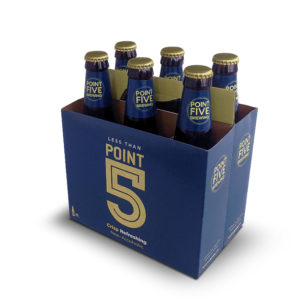Many health-conscious beer lovers, who have been looking for suds without the buzz, just haven’t found the right brew. The problem is that alternatives, with less alcohol, don’t taste like the real thing — not even close.
Point Five, a new easy-drinking pilsner with alcohol “gently removed,” has been creating a buzz among beer lovers since its launch in Boston in December. The name of the beer comes from the American definition of a nonalcoholic beer — a brew with less than one-half of 1 percent alcohol.
“Nonalcoholic beers just haven’t tasted that great,” says Ronan McGovern, the scientist-entrepreneur behind Point Five. While he was a graduate student at the Massachusetts Institute of Technology, he developed an energy-efficient desalination process during his PhD. He realized that brewers could use this separation technology to remove water from beer and save on transportation costs. In 2015, while he was a postdoc at the institute, he launched the startup Sandymount Technology.
Soon, some clients began to ask, could they remove alcohol from the beer as well, without altering the taste? When this goal was accomplished, McGovern went on launch the brew. The pilsner is made by Matt Brewing Company in upstate New York. This would be a new venture.
A good nonalcoholic beer was appealing to him personally. “I am not a big juice or soda drinker, and I do like beer,” says McGovern. Further, McGovern knew of the recent surge of sales of nonalcoholic beers in his native Ireland, where beer remains the most popular alcoholic drink.
By all accounts, folks the world over were looking to drink less alcohol for a variety of reasons. Millennials, who are more health conscious than previous generations, consume less fat and sugar, and look for choices with fewer calories in both food and drink. They don’t want to drink and drive. For a business lunch, an NAB works better than regular beer.
Though nonalcoholic beers have been growing in Europe for a while now, the increased interest is a very recent phenomenon in the United States. In 2019, the prestigious Great American Beer Festival brought back nonalcoholic beer as a competition category, after a long hiatus, says Ann Obenchain, marketing director of Brewers Association, which organizes the festival. (In 2006, the category had been scrapped due to lack of interest or participation.)
Some of this recent interest, industry watchers say, is “producer push” as much as “consumer pull.” For instance, Heineken, which saw Heineken 0.0 do well in Europe, was willing to invest in greater marketing in the United States last year.
While there are many factors in the resurgence of nonalcoholic beers, “People want to be part of the crowd, but not get drunk,” says Steven Wilkinson, general manager of Supreme Liquors. Not too long after Point Five’s December launch, customers came in asking for the beer, even before he had a chance to stock the item in all the stores in his chain.
Initially, Wilkinson thought the buzz for Point Five was because of social media. “In the past, customers have not always liked nonalcoholic beer once they’ve tasted it,” he says. But they have kept coming back for Point Five because, he says, it is “a truly good product.”
There are different approaches to making nonalcoholic beer. Brewers could arrest the fermentation process. Think partially fermented grape juice instead of proper red wine. Another method is to brew a conventional beer and later remove the alcohol by distilling it out with heat, or by a cold filtration process. Either way, the fresh fermented notes of the original beer are typically lost because the smaller aromas tend to evaporate.
This is where the Point Five innovation is different — its cold filtration process has greater accuracy of separation, so there is no need to add flavors back. “Here is how you make great nonalcoholic beer,” says McGovern. “Fermentation, which makes beer taste like beer, followed by a careful separation of alcohol that keeps all the key aromas in the brew.” This process distinguishes the product from what is already out there.
“Point Five is a nonalcoholic with global appeal,” says Roy Desrochers, the sensory practice leader at the University of Vermont Extension, a professional beer taster with over 35 years of experience teaching beer flavor around the world. In his assessment, Point Five retains the aromas and flavors of the original brew and has no off-putting features, no burnt taste or “wet-cardboard” staleness. “Point Five will meet the expectations of beer-drinkers who want to drink nonalcoholic beer, but don’t drink nonalcoholic beer currently,” he predicts.
Right now, Point Five sells in stores only in Boston. But since the first of March, it has been available on NACraftBeverages.com.
Credit: By Vijee Venkatraman Globe correspondent
